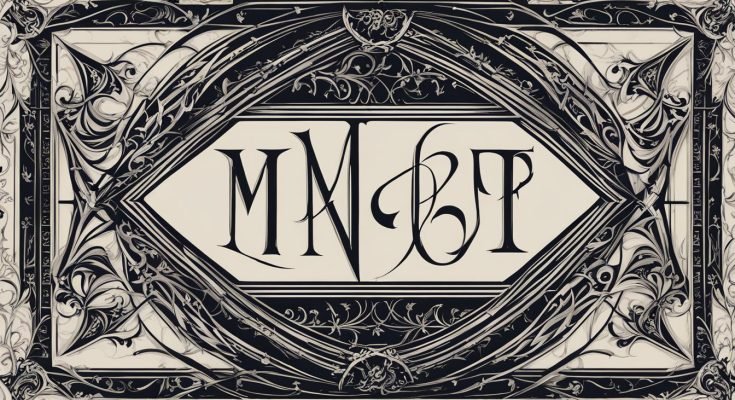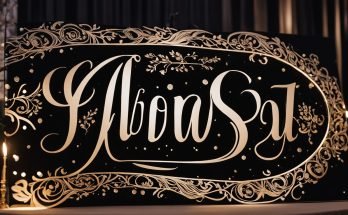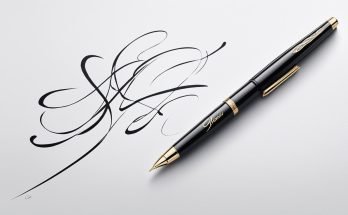Gothic Revival Calligraphy Styles: Discover the Timeless Elegance of Classic Lettering
Are you fascinated by the art of calligraphy? If so, you’re in for a treat with Gothic Revival Calligraphy Styles. This classic form of calligraphy, also known as Gothic calligraphy or Revival calligraphy, has a rich and storied history that predates many other popular calligraphy styles.
Gothic Revival Calligraphy Styles, often referred to as Gothic script, were inspired by the architecture of gothic cathedrals and first emerged in Northern Europe during the 11th century. Initially used by bishops and missionaries for bible translation, these calligraphy styles have since become beloved for their intricate and ornate lettering.
From the intricate and structured forms of Textura to the expressive and flowing lines of Bastarda, there are various Gothic Revival Calligraphy Styles to explore. Each style is unique, reflecting the influence of different regions and periods throughout history.
Ready to dive into the world of Gothic Revival Calligraphy Styles? Join us as we explore the different calligraphy styles, tools and materials needed, and techniques to get started. Discover the impact of Gothic calligraphy on Western letterforms and gain a deeper appreciation for the beauty of historical calligraphy.
Key Takeaways:
- Gothic Revival Calligraphy Styles have a rich history that predates other popular calligraphy styles.
- Blackletter is a reference to a variety of gothic calligraphy styles, categorized as Textura, Rotunda, Bastarda, and Fraktur.
- Gothic calligraphy can be created using broad-edged tools, such as brushes, pens, markers, and classic quills.
- Practice techniques include holding the pen at an angle, creating diamond shapes, and mastering the thick downstrokes.
- Gothic calligraphy has influenced Western letterforms, including the development of Roman and italic type fonts.
Understanding the Varieties of Blackletter
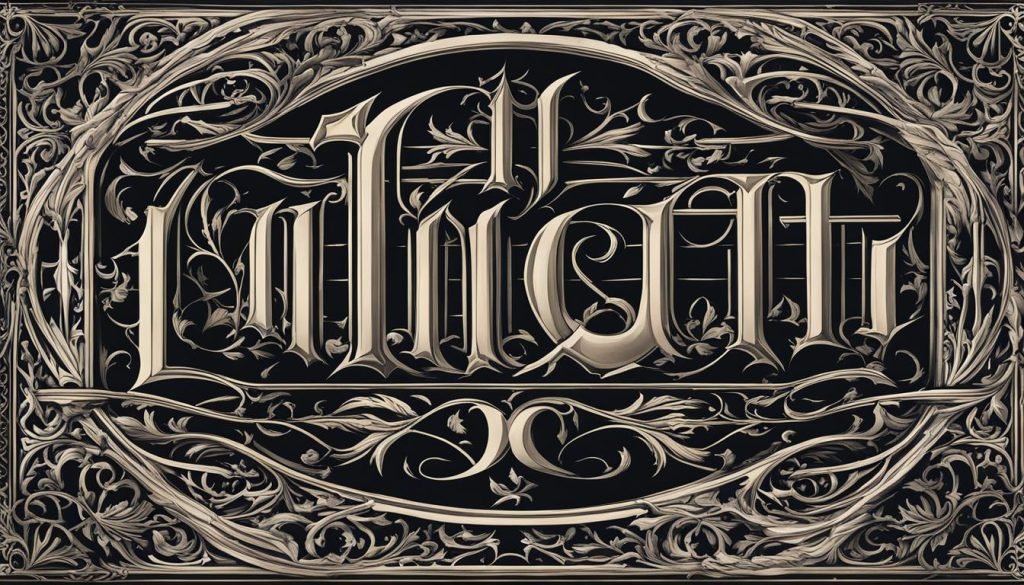
Blackletter, also known as Gothic calligraphy, encompasses various styles that can be categorized into four main variants. Each style possesses unique characteristics, reflecting the diverse influences and historical developments in Gothic Revival Calligraphy Styles.
1. Textura
Textura is a rigid and vertically structured form of blackletter that originated in the 11th century. Its name derives from the Latin word “textus,” meaning “textured” or “woven.” This style features dense vertical strokes and angular shapes, resulting in a distinctively Gothic aesthetic.
2. Rotunda
Rotunda, inspired by Textura, emerged as a more rounded and flowing form of blackletter. It gained popularity during the late Middle Ages and early Renaissance. Rotunda shares similarities with Textura but introduces more curved and less angular letterforms, making it appear softer and more approachable.
3. Bastarda
Bastarda, also known as Batarde, presents a more expressive and cursive version of Textura and Rotunda. This style of blackletter calligraphy combines the rigid structure of Textura with elements of cursive writing. Bastarda offers an elegant balance between legibility and artistic flourishes.
4. Fraktur
Fraktur, rooted in the German blackletter tradition, developed as a more formalized and rhythmic style. It encompasses both Textura and Bastarda influences while introducing additional script variations. Fraktur became particularly popular in Germany and Central Europe during the 16th and 17th centuries.
These four main styles of blackletter calligraphy—Textura, Rotunda, Bastarda, and Fraktur—represent distinct periods and geographic influences within the broader scope of Gothic Revival Calligraphy Styles.
| Style | Description |
|---|---|
| Textura | Rigid and vertically structured blackletter style originating in the 11th century. |
| Rotunda | Rounder and softer forms of blackletter inspired by Textura. |
| Bastarda | Expressive and cursive version of Textura and Rotunda. |
| Fraktur | Formalized and rhythmic blackletter style with German influences. |
Tools and Materials for Gothic Calligraphy
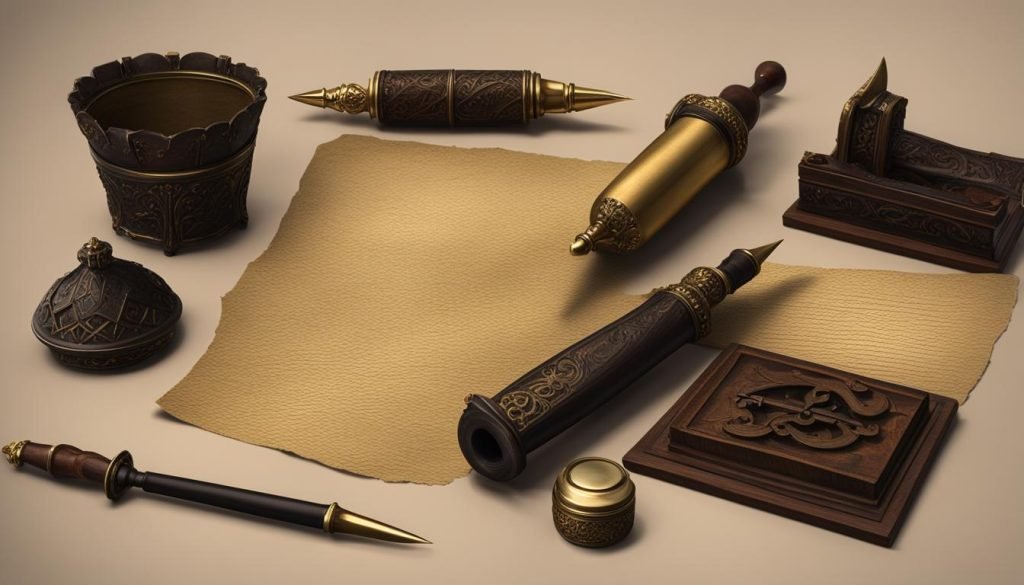
Writing blackletter calligraphy requires the use of broad-edged tools that can create thick and thin lines. To achieve the distinctive style of Gothic Revival Calligraphy, consider the following tools and materials:
1. Calligraphy Tools
When it comes to Gothic calligraphy, you have several options for tools:
- Brushes: Brushes offer versatility and control, allowing you to create expressive strokes.
- Pens: Traditional pens, such as classic quills or modern calligraphy pens, are excellent options for precise lettering.
- Markers: Calligraphy markers provide convenience and ease of use, making them ideal for beginners.
One highly recommended tool for beginners and experienced calligraphers alike is the Pilot Parallel pen. This pen is available in various sizes, allowing you to experiment and achieve different line widths with ease.
2. Paper
While basic ink can be used on almost any type of paper, using thicker paper can prevent bleeding and enhance the visual impact of your calligraphy. Consider using bristol paper or mixed media marker pads. These papers have a heavier weight and are specifically designed to handle wet ink without smudging or bleeding.
3. Guides
Working with guides can greatly assist your Gothic calligraphy endeavors. Using a guide ensures consistency in letter height and spacing. For blackletter calligraphy, a 2:4:2 ratio guide is recommended. This means that lowercase letters should sit on the x-height, ascenders should reach the ascender line, and descenders should reach the descender line.
Here’s an example of how the guide would look:
| Line Type | Height |
|---|---|
| x-height (lowercase letters) | 2 units |
| Ascender line (tall letters like b, d, and k) | 4 units |
| Descender line (letters with tails like g, j, and y) | 2 units |
Using these tools and materials, you’ll be well-equipped to explore the captivating art of Gothic calligraphy and unleash your creativity.
Getting Started with Blackletter Calligraphy
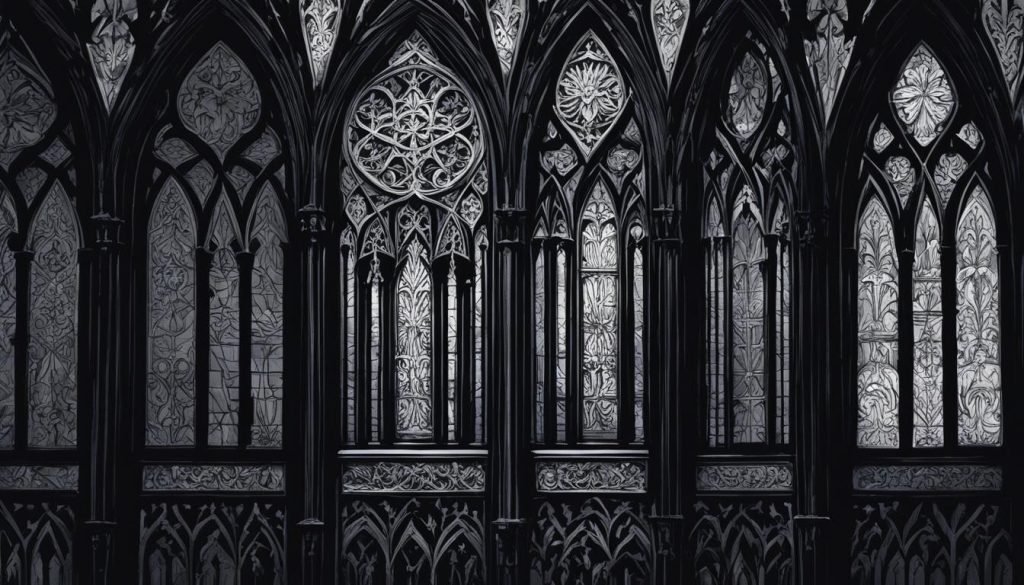
Starting with blackletter calligraphy can feel overwhelming, but the best way to learn is through practice. By following some basic techniques and incorporating diamond shapes and downstrokes, you can begin your journey into the beautiful world of Gothic Revival Calligraphy Styles.
Holding the Pen
To create most of the letters in blackletter calligraphy, it is essential to hold your pen or tool at an angle of 40-50 degrees. This angle allows you to achieve the desired thick and thin strokes that give blackletter its distinctive look. Experiment with different grips to find the one that feels most comfortable for you.
Practicing Diamond Shapes
Diamond shapes are a common element in many blackletter letterforms. Practice creating diamond shapes by ensuring that the left and right points of the diamonds are horizontally aligned. This technique will help you develop a sense of symmetry and proportion in your lettering.
Mastering Downstrokes
One of the defining characteristics of blackletter calligraphy is the thick downstrokes. Practice creating basic downstrokes, ensuring that they are thick and consistent. As you become more confident, incorporate diamond shapes into your downstrokes to add visual interest to your letterforms.
Remember, learning blackletter calligraphy takes time and dedication. Regular practice and patience are key to mastering the art. Embrace the beauty and elegance of Gothic Revival Calligraphy Styles, and let your creativity flow.
| Practice Techniques | Benefits |
|---|---|
| Hold the pen at a 40-50 degree angle | Achieve thick and thin strokes |
| Create diamond shapes | Develop symmetry and proportion |
| Incorporate downstrokes | Add visual interest to letterforms |
The Evolution and Impact of Blackletter Calligraphy
# The Evolution and Impact of Blackletter Calligraphy
Blackletter calligraphy has a long and fascinating history. It traces its origins back to scripts like Carolingian minuscule and protogothic, which emerged in medieval Europe. These early forms of writing laid the foundation for blackletter calligraphy and its subsequent development into various styles.
One of the most significant stages in the evolution of blackletter calligraphy was the emergence of *textualis*, also known as textura. Textualis is characterized by its dense and uniform appearance, with tightly packed vertical strokes and angular letterforms. This script style became the dominant form of blackletter in the 13th and 14th centuries and is often associated with the Gothic period.
As blackletter calligraphy continued to evolve, new styles emerged, reflecting changing aesthetics and influences. One such style is *cursiva bastarda*, also known as lettre bâtarde. Cursiva bastarda combined elements of blackletter calligraphy with cursive script, resulting in more fluid and expressive letterforms with flourishing ascenders and descenders.
The rise of humanism in the 14th and 15th centuries also had a significant impact on the development of blackletter calligraphy. Humanism emphasized the study of classical texts and the revival of ancient Roman culture. Scholars like Coluccio Salutati and Niccolò Niccoli played pivotal roles in shaping the scripts used in humanistic manuscripts, leading to the development of more refined and elegant forms of blackletter calligraphy.
An important influence on the evolution of blackletter calligraphy was the study of ancient Roman inscriptions. This study led to the development of square capital letters and geometric approaches to lettering, which found their way into blackletter scripts. The geometric precision and clean lines of these letterforms added a sense of balance and order to blackletter calligraphy.
To understand the evolution and impact of blackletter calligraphy, it is worth examining its historical development and the key players who shaped its trajectory. The following table provides an overview of the different stages of blackletter calligraphy and the prominent script styles that emerged during each period:
| Period | Script Style |
|————————-|—————–|
| Carolingian minuscule | Protogothic |
| Protogothic | Textualis |
| Textualis | Cursiva bastarda|
*Image source: [Gothic Revival Calligraphy Styles](https://seowriting.ai/32_6.png)*
The evolution of blackletter calligraphy showcases the dynamic nature of the art form and its ability to adapt to changing cultural and artistic influences. The interplay between historical developments, such as the rise of humanism, and the exploration of new scripts demonstrates the enduring appeal and impact of blackletter calligraphy.
*Quote:*
> “Blackletter calligraphy has seen remarkable transformations throughout history, capturing the zeitgeist and cultural shifts of different periods.” – Unknown
By appreciating the historical journey of blackletter calligraphy, we gain a deeper understanding of its significance in the broader context of letterform aesthetics. The intricate and elaborate nature of blackletter scripts continues to captivate and inspire artists, calligraphers, and enthusiasts today.
Keep exploring the world of gothic revival calligraphy styles, as we move on to discover the notable blackletter script styles in the next section.
Notable Blackletter Script Styles
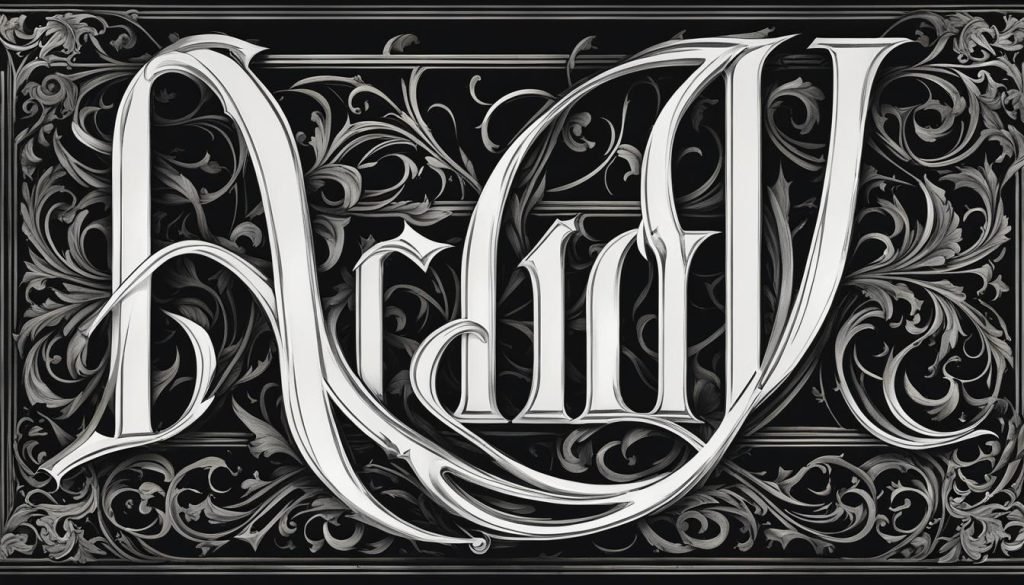
Blackletter calligraphy offers a wide range of distinct styles, each with its own characteristics and appeal. Let’s explore some of the notable black-letter styles:
Textualis precissa
The Textualis precissa style is known for its horizontally ending feet on several minims, giving it a unique visual presence. This style of blackletter script showcases the precision and attention to detail that is characteristic of Gothic Revival Calligraphy Styles.
Textualis quadrata
In the Textualis quadrata style, the letters feature diamond-shaped feet that perfectly match the serifs at the top. This creates a harmonious and balanced look that is both visually striking and historically significant in the realm of black-letter calligraphy.
Textualis rotunda
Textualis rotunda stands out with its condensed and curved letters, giving it a distinctive aesthetic appeal. This style exudes elegance and sophistication, and its rounded forms create a unique rhythm to the overall composition.
Cursiva bastarda
Cursiva bastarda, also known as lettre bâtarde, combines elements of black-letter script with cursive handwriting. It features flag-like serifs on ascenders, resulting in a script that beautifully blends the formality of blackletter calligraphy with the flowing nature of cursive script.
Bastard secretary cursive
Bastard secretary cursive, commonly used in French and Flemish manuscripts, showcases rightward sloping letters with looped serifs on the ascenders. This style carries a sense of fluidity and movement, making it a popular choice for those seeking a unique and compelling blackletter script.
These notable blackletter script styles offer a glimpse into the richness and variety of Gothic Revival Calligraphy Styles. Each style brings its own unique flair and historical significance, making them a captivating choice for those looking to explore the beauty and intricacy of blackletter calligraphy.
The Influence of Blackletter on Western Letterforms
Blackletter calligraphy has had a significant impact on the development of Western letterforms. This influence can be seen in various aspects of lettering, from the evolution of the Roman alphabet to the development of square capitals and the birth of the humanistic script.
The Roman Alphabet and its Origins
The Roman alphabet, which is widely used today, is derived from the Phonecian alphabet. However, the development of the Roman script was not isolated from the influence of blackletter calligraphy. Scripts like Roman Cursive and Uncial played a role in shaping the forms of the letters we use in the Roman alphabet.
Square Capitals and Geometric Approaches
The development of square capitals, characterized by their precise and angular shapes, can also be attributed to the influence of blackletter calligraphy. Scholars like Felice Feliciano explored geometric approaches to lettering, resulting in the creation of square capitals that have become synonymous with classical and ancient aesthetics.
The Birth of the Humanistic Script
One of the most significant contributions of blackletter calligraphy to Western letterforms is the birth of the humanistic script. Developed by Niccolò Niccoli and Gian Francesco Poggio Bracciolini during the Renaissance, the humanistic script was inspired by the classical letterforms of ancient Rome. This new script served as the prototype for both the Roman and italic type fonts, profoundly influencing the letterforms that we use today.
Overall, blackletter calligraphy has left a lasting impact on Western letterforms. From the evolution of the Roman alphabet to the development of square capitals and the birth of the humanistic script, the influence of Gothic Revival calligraphy styles can still be seen in the lettering we encounter in our daily lives.
Conclusion
Gothic Revival Calligraphy Styles, also known as blackletter or gothic calligraphy, have a rich history that predates other calligraphy styles. The varieties of blackletter, such as Textura, Rotunda, Bastarda, and Fraktur, offer distinct and visually striking letterforms that have captivated artists and enthusiasts for centuries.
By delving into the world of gothic revival calligraphy, you can discover the beauty of historical lettering and classic scripts. The intricate details and letterform aesthetics of blackletter calligraphy provide a unique and elegant touch to your lettering projects.
Blackletter calligraphy’s influence on Western letterforms cannot be understated. It has played a significant role in the development of Roman and italic type fonts, as well as the shaping of letterforms we use today. By embracing the elegance and sophistication of gothic revival calligraphy styles, you can bring a timeless charm to your own lettering creations.
FAQ
What are Gothic Revival Calligraphy Styles?
Gothic Revival Calligraphy Styles refer to a collection of calligraphy styles that have a rich history predating other popular calligraphy styles like Copperplate or Spencerian. These styles are often interchangeably referred to as Old English or gothic calligraphy, and they originated in Northern Europe during the 11th century.
How many main styles are there in Gothic calligraphy?
Gothic calligraphy, also known as blackletter, can be categorized into four main styles: Textura, Rotunda, Bastarda, and Fraktur. Each style has its unique characteristics and influences, resulting in numerous variations.
What tools and materials are used in Gothic calligraphy?
Gothic calligraphy requires the use of broad-edged tools that can create thick and thin lines. Popular tools include brushes, pens, markers, and classic quills. The Pilot Parallel pen is a versatile and affordable option for beginners. When it comes to paper, basic ink can be used on almost any type, but thicker paper like bristol or mixed media marker pads can prevent bleeding. Working with guides is recommended for accuracy.
How can I get started with Blackletter calligraphy?
Starting with Blackletter calligraphy can feel overwhelming, but the best way is to just start practicing. Hold your pen or tool at an angle of 40-50 degrees to create most of the letters. Practice creating diamond shapes, which are common in many letterforms, by ensuring the left and right points are horizontally aligned. Downstrokes are always thick in blackletter, and practicing basic downstrokes and adding diamonds into them can help improve your skills.
What is the history of Blackletter calligraphy?
Blackletter calligraphy has a long and fascinating history. It evolved from scripts like Carolingian minuscule and protogothic and developed into different styles such as textualis and cursiva bastarda. Scholars like Coluccio Salutati and Niccolò Niccoli played significant roles in shaping the scripts used in humanistic manuscripts. The study of ancient Roman inscriptions also influenced the development of square capital letters and geometric approaches to lettering.
Are there any notable styles of Blackletter scripts?
Yes, there are several notable styles of Blackletter scripts. Textualis precissa features horizontally ending feet on several minims, while textualis quadrata has diamond-shaped feet that match the serifs at the top. Textualis rotunda is characterized by condensed and curved letters, while cursiva bastarda, also known as lettre bâtarde, combines black letter and cursive script with flag-like serifs on ascenders. Bastard secretary cursive has rightward sloping letters and looped serifs on ascenders.
How has Blackletter calligraphy influenced Western letterforms?
Blackletter calligraphy has had a significant impact on the development of Western letterforms. The Roman alphabet, derived from the Phoenician alphabet, was influenced by scripts like Roman Cursive and Uncial. The development of square capitals and geometric approaches to lettering also played a role, thanks to scholars like Felice Feliciano. The humanistic script, developed by Niccolò Niccoli and Gian Francesco Poggio Bracciolini, served as the prototype for Roman and italic type fonts, shaping the letterforms we know today.

